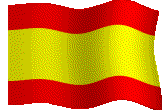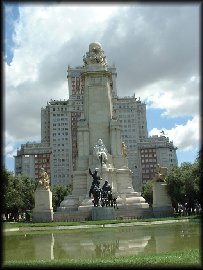TWC'S ODYSSEY
MADRID
Bullfights and suckling pig in a wet Madrid



Bullfights and suckling pig in a wet Madrid



Gallery: Bull-Fighting - At the Bull Ring
Gallery: Bull-Fighting - A Cafe with a Theme
Gallery: Old & Alternative Madrid
Luis,
the matador (bullfighter, as he is popularly known to the uninitiated), raises
the sword, preparing to drive it into the bull’s shoulder blades.
He has to sever the bull’s aorta, if not drive another one to sever its
spinal cord. The clock is clicking
away, 3 minutes have passed, another 7 minutes to go.
If he doesn’t make it, a warning would be given and the crowd can
petition the judge to let the bull go if they sympathise with the bull.
However, this seldom happens. Seldom
does a bull emerge alive from a faena (session), which usually lasts 15 minutes.
The bullfight is often romantically as a battle to death in which either
participant, man or bull, may die. The
fact is that, the bull has hardly any chances at all.
At
this point, indeed, the three-year-old bull, which appears to be so violently
fierce and energetic to a casual observer, is a seriously injured and deeply
confused creature. Its neck muscles
and back were already broken from the start of the faena, when assistants of the
matador – junior guys called picadors – rode in on horseback and speared its
neck and back repeatedly, so as to prevent it from raising its head too high.
In fact, the very act of raising its head causes unbearable pain.
This was followed by five banderilleros, another group of sidekicks
commanded by the matador, who waved pink flags to distract the bull, and stabbed
it repeatedly with colourful daggers – perhaps they were trying to give it a
disneyesque feel. By now, the bull
has at least four daggers stuck to its bloodstained back.
Occasionally, it mastered the strength to charge at its attackers, but
they inevitably ran behind tough wooden barriers, leaving the bull goring
helplessly at the barriers, while getting it exposed to further attacks by other
banderilleros from behind. I wonder
if this is a fair battle. Given the
injuries, even if the matador does not perform the final act, death for the bull
is only a matter of time.
By
then, Luis, the star matador, whose fans rival that of superstars, has to
perform more than a mere butcher’s job. He’s
an artist, or at least perceived as such, and he has to kill the bull in such
grace and fashion that will please the crowds.
As Ernest Hemingway had said in “Death in the Afternoon”, the bull is
not the place for skill without risk. According
to the New York Times 25th September 1932, Hemingway was once
disgusted with a matador who kills by a trick stroke “bulls that he is
supposed to expose his body to in killing with the sword.” If the finishing
thrust is properly put in, the matador must always be in such a position that if
a gust of wind comes at the wrong time or if the bull suddenly raises his head
the man will be gored.
The right moment came, and Luis drove the sword into the bull – it jerked and turned round, blood spurting from its broken artery. The giant, or rather, what’s left of it after multiple mob stabbings, sank to the ground. The crowd stood up, cheering their hero – the matador of course, waving fervently white handkerchiefs in the air. The audience had petitioned for an award for the their hero, and the judge had to acknowledge by granting Luis the bull’s ear, a coveted prize for all matadors. Luis stepped forward, cut one of the bull’s ears, and held it high to present it to his admirers – no different from an Olympic champion honouring his fans shortly after receiving his trophy. The crowd roared and clapped. A group of workmen came forward with a pair of elegant horses, whose eyes were covered lest they saw the ghastly sight, attached the dead creature to the horses, and then had the horses dragged round the ring and finally out of the ring altogether. The crowd clapped wildly.
<Click here for a gallery of bull fighting photos>
----
I
arrived in Madrid late on Friday night. The
Iberia flight was 45 minutes late and I took the taxi straight to Botin, a
restaurant where I was supposed to meet B., my colleague in Madrid.
He had made a reservation at this famous restaurant, founded in 1625, and
listed in the Guinness Book of Records as the world’s oldest. Wooden-beamed dining rooms and cast-iron ovens.
Goya was supposed to have worked here and Hemingway loved the food.
The ambience was great and the roast suckling pig was heavenly. After dinner, we went bar-hopping in Madrid.
The Madrid of today is a far cry from what it was 30 years ago during the
strict Catholic days of Franco. The
Spain of today is liberal, hip and fun-loving – some of the public advertising
posters would have raised the ire of public authorities in USA or the UK.
Madrid has become, in the words of tourism brochure, the party town of
Europe. Franco must be turning in
his grave.
I
woke up at 9:30am, considered late by my normal travel schedule, and wandered
around the old town. Bumped into a cool American scientist and we explored the Old
Madrid together. Plaza Mayor,
Puerta del Sol, Plaza de la Villa – all old squares that reminded one of the
old Moorish Spain, the Catholic Spain, the imperial Spain as well as the
revolutionary Spain… We had wonderful Paella Valenciana and then proceeded to
the Prado, a great treasure trove of European art across the ages. Enough of art and then nice Café Americano at the
ornate Puerta de Alcala, which was somehow covered with thousands of books
wrapped in plastic bags in a crude attempt at modern art.
OK, maybe I just simply do not understand art.
As
the skies started drizzling with gentle summer rains, we had a plate of
wonderful calamari at a tapas bar (NOT topless bar), and then rushed to the
Plaza de Toros (i.e., bull ring) for the grand finale of the San Isidro
bullfight season. It’s my first
and perhaps last time at a bull-fight (OK – don’t hold me to it, I’m known
to be promiscuous in the way I change my travel plans or habits).
I am not a fan of bull-fighting. Personally
I think it’s cruel and too much of a bloodbath for me.
However, as a connoisseur of shark fins, bird nests and other fine
Chinese delicacies that turn most species endangered, I have no moral authority
to preach against bullfighting. In
fact, I think any meat eater has no right whatsoever to rile against it. To the Spanish people, bull-fighting is too much a national
symbol to give up. It seems that
most of the opponents are Anglo-Saxons, who, as a Spanish friend puts it, all
seem to be members of the Society for the Prevention of Cruelty to Animals.
What is perhaps a manifestation of cultural double standards is that the
Anglo-Saxons are also great practitioners of industrial animal farming, the
abuse of which have probably led to foot and mouth, and the infamous mad cow
diseases. Which is more cruel ?
I suppose there is no answer. The
world gets a lot more complicated when one attempts to analyse matters from
different cultural and political perspectives, rather than simply in pure
black-and-white basis.
Sunday
was a slow day for me in Madrid. Another
late night the previous day meant another slow get-up.
I strolled along the streets of old Madrid, have breakfast at a nice café,
followed by a visit to the Royal Palace. Amazing
exuberance and glories of Spain… perhaps built from the blood and souls of the
people of the Americas. No wonder
after the empire collapsed, the mother country struggled from one civil war to
another in the 19th and 20th centuries. Nearby was Plaza de Espana, with the statues of
Cervantes, Don Quixote and his sidekick Sancho Panza.
I stood there, contemplating the reflection of the statues onto the calm
algae-filled waters, and wondered about the state of the New World Order a la
George W. Bush. Nearby, crowds were
demonstrating against the new master of the Universe who would be visiting the
following day. The Texan had come
to power with less than half the votes, bombed the Iraqis almost immediately,
offended the S. Korean allies, declared the Chinese enemies, and pissed off
everybody else by tearing environmental treaties apart.
I’m not sure who’s Don Quixote and who’s his invisible enemies, but
I wouldn’t be surprised if there is more trouble to come.
OK,
enough said. Madrid is great, and
in September I will be back to the wonderland that is Spain.
In the mean time, take care and hear from me again in 2 weeks’ time,
from the Channel Islands.
Regards,
WeeCheng
Click here to send your comments to Tan Wee Cheng, Singapore
Click here to visit the author's homepage, Nomadic Tales